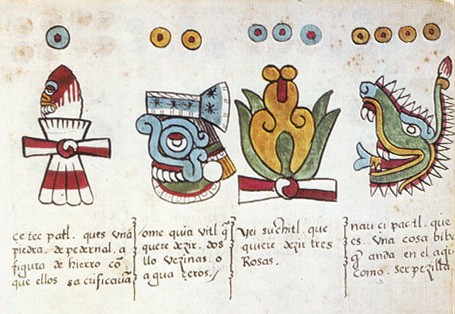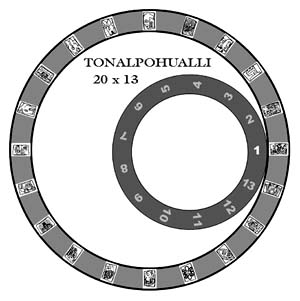Tōnalpōhualli on:
[Wikipedia]
[Google]
[Amazon]

 The (), meaning "count of days" in
The (), meaning "count of days" in
 The term for the
The term for the
File:Flower,Wind,Flint,Earthquake.jpg, Flower, Rain, Flint, Earthquake
File:Vulture,Eagle,Jaguar.jpg, Vulture, Eagle, Jaguar
File:Reed,Grass,Monkey,Dog.jpg, Reed, Grass, Monkey, Dog
File:Water,Rabbit,Deer.jpg, Water, Rabbit, Deer
File:Lizard,Snake,Death.jpg, Death, Snake, Lizard
File:House,Wind,Alligator.jpg, House, Wind, Alligator
Discussion of origin of the 260-day cycle
Animated tōnalpōhualli
{{Calendars , state=collapse Aztec calendars Specific calendars Obsolete calendars Nahuatl words and phrases

 The (), meaning "count of days" in
The (), meaning "count of days" in Nahuatl
Nahuatl ( ; ), Aztec, or Mexicano is a language or, by some definitions, a group of languages of the Uto-Aztecan language family. Varieties of Nahuatl are spoken by about Nahuas, most of whom live mainly in Central Mexico and have smaller popul ...
, is a Mexica
The Mexica (Nahuatl: ; singular ) are a Nahuatl-speaking people of the Valley of Mexico who were the rulers of the Triple Alliance, more commonly referred to as the Aztec Empire. The Mexica established Tenochtitlan, a settlement on an island ...
version of the 260-day calendar in use in pre-Columbian
In the history of the Americas, the pre-Columbian era, also known as the pre-contact era, or as the pre-Cabraline era specifically in Brazil, spans from the initial peopling of the Americas in the Upper Paleolithic to the onset of European col ...
Mesoamerica
Mesoamerica is a historical region and cultural area that begins in the southern part of North America and extends to the Pacific coast of Central America, thus comprising the lands of central and southern Mexico, all of Belize, Guatemala, El S ...
. This calendar is solar and consists of 20 13-day () periods. Each is ruled by a different deity. Graphic representations for the twenty day names have existed among certain ethnic, linguistic, or archaeologically identified peoples.
Description
 The term for the
The term for the Aztec
The Aztecs ( ) were a Mesoamerican civilization that flourished in central Mexico in the Post-Classic stage, post-classic period from 1300 to 1521. The Aztec people included different Indigenous peoples of Mexico, ethnic groups of central ...
day signs, ''tōnalpōhualli'', comes from the root word ''Tona'' which means to give light or heat. T''ōnalpōhualli'' refers to the count of the days, made up of 20 day signs and a 260 day cycle. In Aztec society there were multiple intertwining calendars, the ''tōnalpōhualli'', and the '' xiuhpōhualli'' which refers to the solar year of 365 days. The '' xiuhpōhualli'' was divided into eighteen twenty day months, and then an extra five days at the end of the cycle. Each day denoted by a different day sign and number, the double calendars were intertwined so that every 52 years the same combination of day signs and numbers would appear again. The full ''tōnalpōhualli'' cycle would take place over 260 days and since each day was unique in number and symbol each had its own intrinsic meaning. It is likely that the root of these units comes from the human body: the Aztecs would count using all digits on their body consisting of the 20 day signs. The 260 cycle likely originated from womans’ gestational cycle, as from the time of the first missed menstruation cycle to the time of giving birth is roughly 260 days.
The ''tōnalpōhualli'' as aforementioned consists of twenty different day signs or Trecena
A trecena (From Spanish: trece) is a 13-day period used in pre-Columbian Mesoamerican calendars. The 260-day Mayan calendar (the '' tonalpohualli'') was divided into 20 trecenas. Trecena is derived from the Spanish chroniclers and translates to ...
s, which in almost all representations are accompanied with a glyph depicting its character. The Aztec
The Aztecs ( ) were a Mesoamerican civilization that flourished in central Mexico in the Post-Classic stage, post-classic period from 1300 to 1521. The Aztec people included different Indigenous peoples of Mexico, ethnic groups of central ...
form of writing is largely pictorial and was a semasiographic system, meaning writing existed separately from spoken word. The glyphs were recognizable to their meaning, and members of the population would understand what day it was and their current position in time. Since the Trecena
A trecena (From Spanish: trece) is a 13-day period used in pre-Columbian Mesoamerican calendars. The 260-day Mayan calendar (the '' tonalpohualli'') was divided into 20 trecenas. Trecena is derived from the Spanish chroniclers and translates to ...
s would repeat every twenty days they were accompanied by a number from 1-13. Usually the day count was depicted by small circles next to the main glyph
A glyph ( ) is any kind of purposeful mark. In typography, a glyph is "the specific shape, design, or representation of a character". It is a particular graphical representation, in a particular typeface, of an element of written language. A ...
adding up to the juncture of that day. The glyphs had to be understood by the population so there is a strong level of similarity in depiction of each trecena. However, the day count seems to be up to the discretion of the artist. The first day of the 13 day cycle would be one crocodile (''Cipactli)'' and continue until 13 reeds (''Acatl''). The next 13 day cycle would begin with one jaguar (''Ocelotl'') and continue until 13 death (''Miquiztli''). During this cycle the Trecenas would repeat making the day eight crocodile (''Cipactli)'' and so forth. This pattern would continue until all 20 day signs had been associated with numbers 1 through 13. The Trecena
A trecena (From Spanish: trece) is a 13-day period used in pre-Columbian Mesoamerican calendars. The 260-day Mayan calendar (the '' tonalpohualli'') was divided into 20 trecenas. Trecena is derived from the Spanish chroniclers and translates to ...
s and numbers were two separate identities, the day five deer (''Mazatl'') did not represent there being five deer, nor was there any significance to the number five other than as a defining number. The five relates to the juncture of the day, it comes after day 4 and before day 6 in this specific 13 day cycle. The 13 day cycles are subdivisions of the larger 260 day calendar, and they pertain to different rituals and times of the year. The order of the days related to all aspects of life, they dictated when was the right time to plant maize and when to harvest. People felt that they would be vulnerable if the plantings and festivals didn't take place on the specified days. The gods were also associated with different days, dictating when to hold a feast in each one's honor and which god to pray to. For example, One reed is associated with '' Quetzalcoatl'', while two reeds are associated with '' Omacatl.'' The larger rituals would be on the first half of the 13 day cycles, but other important religious activities were done on specific Tonalpohualli days. For instance, the feast of the sun was held on four movement. Most things in day to day life were dependent on the correlating ''tōnalpōhualli''—even given name. When born, formal names would be the day you were born; for example, 5 lizard (''Cuetzpalin''), and this would determine the child’s destiny. Furthermore, marriages were dependent on the compatibility of the couple’s day signs and numbers.
Day signs
Gallery of day signs
Note that the symbols are arranged counterclockwise around the calendar stone.See also
*Aztec calendar
The Aztec or Mexica calendar is the calendar, calendrical system used by the Aztecs as well as other Pre-Columbian era, Pre-Columbian indigenous peoples of Mexico, peoples of central Mexico. It is one of the Mesoamerican calendars, sharing the bas ...
* Aztec calendar stone
* Aztec mythology
Aztec mythology is the body or collection of myths of the Aztec civilization of Central Mexico. The Aztecs were a culture living in central Mexico and much of their mythology is similar to that of other Mesoamerican cultures. According to legend ...
* Maya calendar
The Maya calendar is a system of calendars used in Pre-Columbian era, pre-Columbian Mesoamerica and in many modern communities in the Guatemalan highlands, Veracruz, Oaxaca and Chiapas, Mexico.
The essentials of the Maya calendar are based upon ...
References
External links
Discussion of origin of the 260-day cycle
Animated tōnalpōhualli
{{Calendars , state=collapse Aztec calendars Specific calendars Obsolete calendars Nahuatl words and phrases